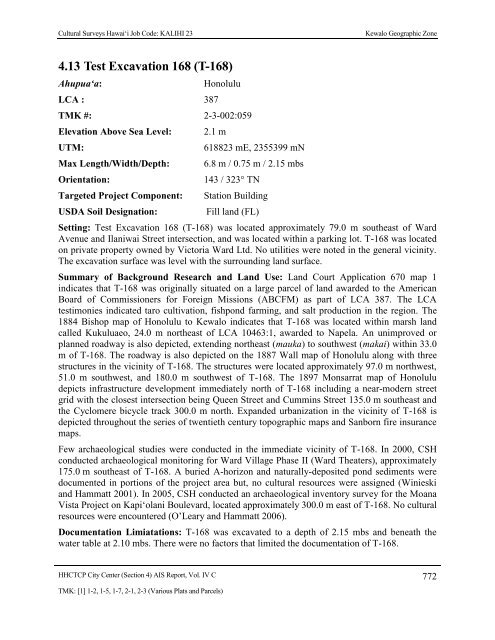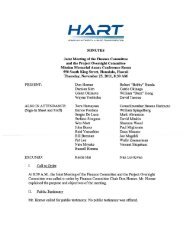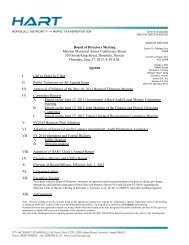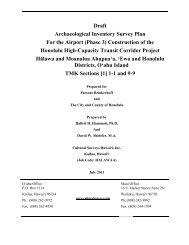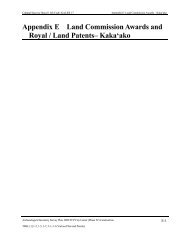4.12 Test Excavation 167 (T-167) - Honolulu Rail Transit Project
4.12 Test Excavation 167 (T-167) - Honolulu Rail Transit Project
4.12 Test Excavation 167 (T-167) - Honolulu Rail Transit Project
Create successful ePaper yourself
Turn your PDF publications into a flip-book with our unique Google optimized e-Paper software.
Cultural Surveys Hawai‘i Job Code: KALIHI 23Kewalo Geographic Zone4.13 <strong>Test</strong> <strong>Excavation</strong> 168 (T-168)Ahupua‘a:LCA : 387<strong>Honolulu</strong>TMK #: 2-3-002:059Elevation Above Sea Level:UTM:Max Length/Width/Depth:Orientation:Targeted <strong>Project</strong> Component:USDA Soil Designation:2.1 m618823 mE, 2355399 mN6.8 m / 0.75 m / 2.15 mbs143 / 323° TNStation BuildingFill land (FL)Setting: <strong>Test</strong> <strong>Excavation</strong> 168 (T-168) was located approximately 79.0 m southeast of WardAvenue and Ilaniwai Street intersection, and was located within a parking lot. T-168 was locatedon private property owned by Victoria Ward Ltd. No utilities were noted in the general vicinity.The excavation surface was level with the surrounding land surface.Summary of Background Research and Land Use: Land Court Application 670 map 1indicates that T-168 was originally situated on a large parcel of land awarded to the AmericanBoard of Commissioners for Foreign Missions (ABCFM) as part of LCA 387. The LCAtestimonies indicated taro cultivation, fishpond farming, and salt production in the region. The1884 Bishop map of <strong>Honolulu</strong> to Kewalo indicates that T-168 was located within marsh landcalled Kukuluaeo, 24.0 m northeast of LCA 10463:1, awarded to Napela. An unimproved orplanned roadway is also depicted, extending northeast (mauka) to southwest (makai) within 33.0m of T-168. The roadway is also depicted on the 1887 Wall map of <strong>Honolulu</strong> along with threestructures in the vicinity of T-168. The structures were located approximately 97.0 m northwest,51.0 m southwest, and 180.0 m southwest of T-168. The 1897 Monsarrat map of <strong>Honolulu</strong>depicts infrastructure development immediately north of T-168 including a near-modern streetgrid with the closest intersection being Queen Street and Cummins Street 135.0 m southeast andthe Cyclomere bicycle track 300.0 m north. Expanded urbanization in the vicinity of T-168 isdepicted throughout the series of twentieth century topographic maps and Sanborn fire insurancemaps.Few archaeological studies were conducted in the immediate vicinity of T-168. In 2000, CSHconducted archaeological monitoring for Ward Village Phase II (Ward Theaters), approximately175.0 m southeast of T-168. A buried A-horizon and naturally-deposited pond sediments weredocumented in portions of the project area but, no cultural resources were assigned (Winieskiand Hammatt 2001). In 2005, CSH conducted an archaeological inventory survey for the MoanaVista <strong>Project</strong> on Kapi‘olani Boulevard, located approximately 300.0 m east of T-168. No culturalresources were encountered (O’Leary and Hammatt 2006).Documentation Limiatations: T-168 was excavated to a depth of 2.15 mbs and beneath thewater table at 2.10 mbs. There were no factors that limited the documentation of T-168.HHCTCP City Center (Section 4) AIS Report, Vol. IV C 772TMK: [1] 1-2, 1-5, 1-7, 2-1, 2-3 (Various Plats and Parcels)


